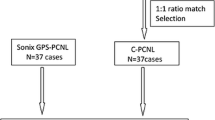Abstract
The objective of the study was to establish and evaluate a modified puncture and dilation technique—“stereotaxic localisation” system—and the corresponding instruments for percutaneous nephrostomy. Four hundred patients were randomised to the intervention group (200 cases, stereotaxic location puncture and dilation procedures) and the traditional group (200 cases, traditional procedure) under X-ray guidance. In the modified intervention system, the distance and horizontal angle of the puncture pathway between the puncture point and the target site were calculated accurately. The time for punctures, time with X-ray exposure and operation, success rate of each puncture to access the target, number of patients requiring blood transfusion, stone clearance, drops of haemoglobin and days of hospital stay were compared between the two groups. In the traditional and intervention groups, the time for puncture was 17 and 7 min, respectively; the X-ray exposure time was 9.1 and 1.3 min; the cases requiring blood transfusion were 9 and 5; and the success rates for each puncture to access the target were 42.9 and 88.0%, all with statistical difference (p < 0.01). The other outcomes and complications revealed similar trends. The stereotaxic localisation system for puncture is statistically better than the traditional procedure used in this study. The stereotaxic localisation system in this study is safer and more accurate, and provides easier access to the target with less bleeding and reduced exposure to X-ray compared to the traditional puncture and dilation procedures of percutaneous nephrostomy.




Similar content being viewed by others
References
Shah HN, Kausik VB, Hegde SS, Shah JN, Bansal MB (2005) Tubeless percutaneous nephrolithotomy: a prospective feasibility study and review of previous reports. BJU Int 96:879–883
Canales BK, Karlovsky ME, Monga M, Seidmon EJ (2007) How small can we go? Percutaneous nephrolithotomy using 6F nephroureteral catheter. Urology 69:629–632
De la Rosette JJ, Laguna MP, Rassweiler JJ, Conort P (2008) Training in percutaneous nephrolithotomy—a critical review. Eur Urol 54:994–1001
Andonian S, Okhunov Z, Shapiro EY, Smith AD, Okeke Z (2010) Diagnostic utility and clinical value of postpercutaneous nephrolithotomy nephrostogram. J Endourol 24:1427–1430
Majidpour HS (2010) Risk of radiation exposure during PCNL. Urol J 10(7):87–89
Mozer P, Conort P, Leroy A, Baumann M, Payan Y, Troccaz J, Chartier-Kastler E, Richard F (2007) Aid to percutaneous renal access by virtual projection of the ultrasound puncture tract onto fluoroscopic images. J Endourol 21:460–465
Shahzadi S, Lozano AM, Bernstein M, Guha A, Tasker RR (1996) Stereotactic management of bacterial brain abscesses. Can J Neurol Sci 23:34–39
Fowler JE Jr, Meares EM Jr, Goldin AR (1975) Percutaneous nephrostomy: techniques, indications, and results. Urology 6:428–434
Aron M, Yadav R, Goel R, Kolla SB, Gautam G, Hemal AK, Gupta NP (2005) Multi-tract percutaneous nephrolithotomy for large complete staghorn calculi. Urol Int 75:327–332
Nagele U, Schilling D, Anastasiadis AG, Corvin S, Seibold J, Kuczyk M, Stenzl A, Sievert KD (2006) Closing the tract of mini-percutaneous nephrolithotomy with gelatine matrix hemostatic sealant can replace nephrostomy tube placement. Urology 68:489–493 discussion 493–494
Noller MW, Baughman SM, Morey AF, Auge BK (2004) Fibrin sealant enables tubeless percutaneous stone surgery. J Urol 172:166–169
Kallidonis P, Stolzenburg JU, Ost M, Keeley F, Traxer O, Bernardo N, Perimenis P, Smith AD (2010) Percutaneous management of staghorn calculi in horseshoe kidneys: a multi-institutional experience. J Endourol 24:531–536
Shah HN, Hegde SS, Shah JN, Bansal MB (2006) Safety and efficacy of supracostal access in tubeless percutaneous nephrolithotomy. J Endourol 20:1016–1021
Rana AM, Mithani S (2007) Tubeless percutaneous nephrolithotomy: call of the day. J Endourol 21:169–172
Tanriverdi O, Boylu U, Kendirci M, Kadihasanoglu M, Horasanli K, Miroglu C (2007) The learning curve in the training of percutaneous nephrolithotomy. Eur Urol 52:206–211
Acknowledgments
The present study was supported by the National Natural Science Foundation of China (NSFC, No. 81070606). The authors are extremely grateful to Dr. Chonghe Jiang, for his elegant work in review and revising this manuscript.
Conflict of interest
All the authors declare that all the devices and inventions included in the patents belong to Xuede Li, and there is no conflict of interest.
Author information
Authors and Affiliations
Corresponding author
Electronic supplementary material
Below is the link to the electronic supplementary material.
Supplementary material 1 (WMV 30342 kb)
Rights and permissions
About this article
Cite this article
Li, X., Liao, S., Yu, Y. et al. Stereotactic localisation system: a modified puncture technique for percutaneous nephrolithotomy. Urol Res 40, 395–401 (2012). https://doi.org/10.1007/s00240-011-0434-2
Received:
Accepted:
Published:
Issue Date:
DOI: https://doi.org/10.1007/s00240-011-0434-2




